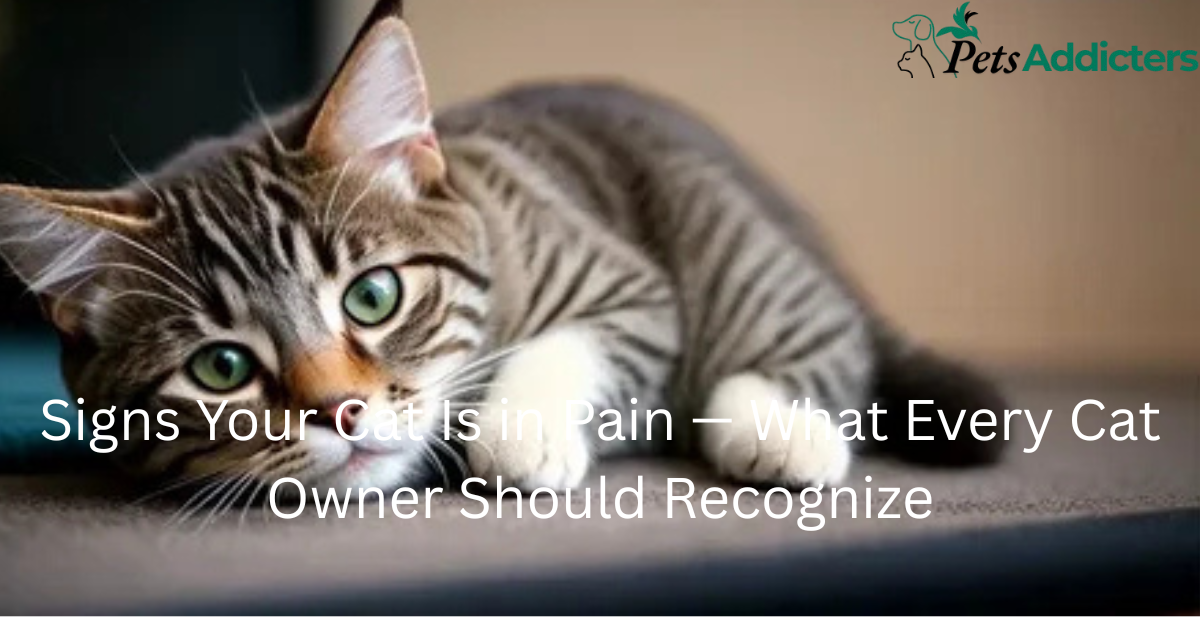Introduction
You know the routine you notice your furry friend a bit off: maybe not playing as much, maybe hiding more frequently. And you wonder: Is he okay? Is he hurting? Here’s what I think: cats are professionals at concealing pain. So if your cat is hurting, it’s up to you to pick up on the subtle clues. Let’s talk about the indicators that your cat is in pain, why they hide it, and how you can step in to help them.
Why Cats Hide Pain
Well, the thing is: in the wild, weakness is bad. So domestic cats retain that instinct — they’ll conceal pain so predators (or people) won’t know. That’s why a cat that seems fine might actually be hurt. Being aware of the subtle cues gives you a huge edge.
also read:common cat disease
Top Signs Your Cat Is in Pain
1. Changes in Behavior
One moment your cat is jumping on the couch, and the next they’re hiding or timid. That flip may be one of the first signs your cat is distressed. Watch for more hiding, avoiding petting, or unusual aggression.
2. Loss of Appetite or Change in Feeding Habits
Cats are consistent as far as feeding is concerned. When your cat suddenly reduces eating, skips a meal, or spurns their usual dish, ask yourself the following question: could something be wrong? Oral, dental, or gastric pain can be responsible for what they want to eat.
3. Limping, Stiffness, or Reluctance to Move
If your cat is cautious while jumping, gets up slowly, or stretches unevenly, you can expect to see mobility issues. These are such strong predictors your cat is in pain — specifically of the joint or muscular variety.
4. Grooming Changes
Cats are self-grooming machines. But if they stop grooming, or over-groom a specific area (licking the same paw over and over), something’s wrong. Skin inflammation, limb or flank pain may be prompting the behavior so pay attention to grooming routines.
5. Changes in Vocalization or Abnormal Vocalizations
Your cat may start meowing more (or less), purring when they’re scared, or letting out small cries you’ve never heard before. These odd sounds can signal discomfort.
6. Litter Box Issues
Sudden accidents, straining in the litter box, or changes in urine/stool could mean pain — especially in their back, hips, or abdomen. If your cat avoids the box or reacts when in it, consider this a serious clue.
7. Posture or Appearance Changes
Is your cat hunched over, curled up, or won’t put a particular paw down? These are physical signs your cat is in distress. Their eyes may be half-closed, or their fur may be rumpled because grooming is painful.
What You Can Do to Help
So you’ve noticed one or two signs now what? Here’s how to react:
- Go see your vet: Especially if you see many signs, or if the change happens quickly. Pain can mean serious issues.
- Provide comfort: Soothing bedding, warm resting spots, reduced jumping if mobility is an issue.
- Sensible diet and weight control: Overweight cats cause more stress on joints, underweight cats could have other health issues.
- Gentle touch: Let your cat initiate petting and avoid pushing on sore areas.
- PROMOTE LIGHT ACTIVITY: Brief gentle play periods keep joints moving but avoid forcing them.
- Follow your vet’s routine: Pain meds, supplements, or physical therapy can be included.
When Pain Signs Might Be an Emergency
When your cat shows: vomiting, collapse, extreme lethargy, cannot walk or use litter box treat it as one. Don’t delay.
Final Thoughts
Cats are stealthy fighters. They won’t necessarily tell you they hurt but they’ll make you aware of it in subtle form. As an unpaid cat caregiver, it’s your responsibility to notice, respond, and tend. So when your cat is “just off,” trust your instincts. It may be one of the key signs your cat is in pain.
How can I tell if my cat is in pain?
Cats rarely show pain directly, but you might notice changes like less movement, hiding, skipping meals, or meowing differently. If your cat avoids touch or looks tense and hunched, those are strong clues they’re uncomfortable.
Why do cats hide their pain?
Here’s what’s fascinating cats instinctively hide pain because, in the wild, weakness could make them a target. So even at home, they pretend to be fine. That’s why it’s so important for pet parents to notice subtle behavior changes.
What should I do if I think my cat is in pain?
Don’t wait too long! Schedule a vet visit right away. Try keeping your cat comfortable and calm avoid handling painful spots and provide soft bedding. Your vet can pinpoint the cause and recommend safe pain relief options.
Can a cat still purr when in pain?
You won’t believe this, but yes some cats purr even when they’re hurting. Purring can actually be a self-soothing behavior, not just a sign of happiness. So if your cat is purring but acting differently, keep an eye out.

